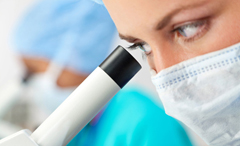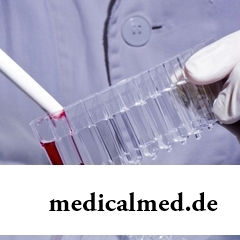





Genetic analysis
 The genetic analysis represents set of various experiences, calculations and observations which purpose is to define ancestral features and to study properties of genes. The analysis on genetic compatibility and the analysis on genetic diseases of the doctor is recommended to pass to women at a stage of planning of a family. Thus, it is possible to predict health of future child in advance, to reveal possible hereditary diseases and to find pathology problem solutions. As a rule, in practice, women carry out the genetic analysis at the pregnancy which already occurred thanks to what the reason of not incubation of a fruit and inborn defects of its development is established.
The genetic analysis represents set of various experiences, calculations and observations which purpose is to define ancestral features and to study properties of genes. The analysis on genetic compatibility and the analysis on genetic diseases of the doctor is recommended to pass to women at a stage of planning of a family. Thus, it is possible to predict health of future child in advance, to reveal possible hereditary diseases and to find pathology problem solutions. As a rule, in practice, women carry out the genetic analysis at the pregnancy which already occurred thanks to what the reason of not incubation of a fruit and inborn defects of its development is established.
Indications for carrying out the genetic analysis at pregnancy
The genetic analysis at pregnancy needs to be carried out in the following cases:
- At the age of the woman more than 35 years;
- If in a family of mother and father of future child hereditary (genetic) diseases took place;
- The previous child was born with inborn malformations;
- When during conception and pregnancy the woman was influenced by harmful factors (X-ray, radiation, drugs, alcohol, reception of some medicines);
- If during pregnancy future mother had an acute viral infection (a SARS, flu, toxoplasmosis, a rubella);
- If in the past the woman had abortions or mortinatus babies;
- All pregnant women entering into risk group on the basis of data of ultrasonography and biochemical analysis of blood.
The gynecologist watching pregnancy will surely appoint to the woman the analysis to genetic compatibility and the analysis on genetic diseases if it concerns so-called risk group. The age is more senior than 35 years when the risk of development of mutations and malformations of a fruit sharply increases. To avoid the unpleasant effects of late pregnancy and other risk factors which are listed above the woman needs to carry out the analysis on genetic compatibility and the analysis on genetic diseases.
For what the genetic analysis is carried out
The main directions of carrying out laboratory researches on the basis of methods of the genetic analysis is the following:
 1. The analysis on genetic compatibility defining paternity, motherhood and other consanguineous relation;
1. The analysis on genetic compatibility defining paternity, motherhood and other consanguineous relation;
2. Detection of genetic predisposition to widespread diseases;
3. Identification of infectious activators;
4. Formation of the genetic passport of the personality.
The analysis on genetic compatibility still is called the analysis of DNA or paternity test. For its carrying out medical indications are not required, and the analysis on genetic compatibility privately, at the request of parents is carried out. Often this type of a research is applied at stains, the section of property and other lawsuits. It is possible to establish degree of relationship of the child and till the birth, during pregnancy.
The analysis on genetic diseases yields 100% result and can reveal predisposition of the child to the following potential problems with health:
- Myocardial infarction;
- Arterial hypertension;
- Fibrinferments;
- Osteoporosis;
- Digestive tract diseases;
- Bronchopulmonary pathologies;
- Diabetes mellitus;
- Diseases of a thyroid gland.
In time having made the genetic analysis at pregnancy, and, having revealed disturbances, it is possible to influence safe incubation of a fruit and to correct health of future child.
All know that there are infections which cannot be revealed by means of the traditional forms of diagnosis which are standardly applied in the course of observation of pregnancy. Methods of the genetic analysis allow to find as fast as possible DNA of infectious activators in an organism, to classify them, to control their behavior and to pick up correct treatment. So, having made the analysis on genetic diseases, it is possible to reveal such widespread pathologies as a Down syndrome, Edwards, etc.
The conclusion of the expert-geneticist creates the genetic passport of the personality by means of methods of the genetic analysis. It is a peculiar form of the combined analysis of DNA where data and its profile, originality of the person contain. These data can give to the person invaluable help throughout life, at various problems with health.
Methods of the genetic analysis
Traditional (noninvasive) methods of the genetic analysis are:
1. ULTRASONOGRAPHY;
2. Biochemical analysis of blood.
Ultrasonography of a fruit as method of the genetic analysis at pregnancy, is carried out on the term of 10 - 14 weeks. On this term it is possible to reveal pathology at the kid. Blood test (biochemistry) begin to do on earlier duration of gestation, it helps to reveal chromosomal and hereditary (genetic) pathology if it takes place. In the presence of suspicions, after the carried-out earlier genetic analysis at pregnancy, later, on term 20 – 24 weeks, do repeated ultrasonography of a fruit. This method of the genetic analysis allows to define small defects in fetation.
If suspicions are confirmed, to the woman appoint invasive methods of the genetic analysis:
- Amniocentesis (research of amniotic waters);
- Chorion biopsy (research of the cells which are a basis of formation of a placenta);
- Platsentotsentez (the procedure for identification of effects after the postponed infection during pregnancy);
- Kordotsentez (research of umbilical blood).
Timely carrying out the analysis on genetic compatibility and the analysis on genetic diseases allows to reveal about 400 types of pathologies from 5000 possible.
As the genetic analysis at pregnancy is carried out
The main methods of the genetic analysis, by means of ultrasonography of a fruit and biochemical analysis of blood, - absolutely safe and harmless ways, both for mother, and for the child. Ultrasonography is carried out through a stomach of the pregnant woman, by means of the special device. Much more rare, apply transvaginal ultrasonography (the device is entered into the woman's vagina). Biochemical analysis is carried out, using blood patients which fence is made from a vein.
At invasive methods of the genetic analysis there is implementation in the woman's organism. So, when performing amniocentesis, a special needle the uterus is punctured and the intake of amniotic liquid (amniotic waters) is made of it. At the same time constant control by means of ultrasonography is exercised. Understand a puncture in an abdominal cavity of the woman for an intake of the material containing cells (a placenta basis), necessary for a research, as a biopsy of chorion. Sometimes, for this analysis, use contents of a neck of uterus. Platsentotsentez is carried out, usually, in the second trimester of pregnancy, under the general anesthesia as this procedure is considered serious operation. Kordotsentez — a method of the genetic analysis at pregnancy, not earlier than 18 weeks. Blood from an umbilical cord gets by means of a puncture, through a cavity of the uterus of the woman. At the same time also do anesthesia.
The American scientists made experiments on mice and came to a conclusion that water-melon juice prevents development of atherosclerosis of vessels. One group of mice drank usual water, and the second – water-melon juice. As a result vessels of the second group were free from cholesteric plaques.

Diapers for adults – individual one-time means of hygiene which in some situations is irreplaceable, and from such situats...
Section: Articles about health
Practically each person is familiar with the annoying, pulling, unscrewing pains caused by overcooling of muscles of a back. In certain cases inflammatory process is not limited to discomfort, being followed by emergence of hypostasis, consolidations, increase температ...
Section: Articles about health
Each of us faces from time to time that other people need the immediate help. We react to it differently: one at once call doctors and police, others rush to victims and try to save them independently. Some pass by at all … Certainly, desire to help the neighbor who got into trouble, quite naturally for any decent person. However not everyone understands that to work in a similar situation, being guided by exclusively good...
Section: Articles about health
The saying "the rich do not know how the other half lives" is known to all. In a broad sense it is that we can not always understand the person, about...
Section: Articles about health
For anybody not a secret that our country is one of the most "drinking" in the world. At clear understanding that the use of hard alcoholic drinks – occupation extremely harmful, most of Russians belong to alcoholism with unjustified loyalty. These...
Section: Articles about health
Tea is loved and use almost everything. This drink has tonic properties, contains the tannins capable to suppress activity of causative organisms. Recently great popularity was gained by teas with vegetable additives. The medicative herbs, spices and fruit which are a part of such mixes enrich drink with vitamins and microelements, increasing its nutritional value and creating additional curative effect....
Section: Articles about health
Impossibility to conceive the child – a trouble of many Russian families. During quite long time was considered that the main "culprits...
Section: Articles about health
More than a half of the married couples which faced prostatitis – leave. The new broadcast "Female View of Prostatitis" will help to learn – whether you have or your relatives problems....
Section: Articles about health
All like to sing. Small children with pleasure are engaged in a vocal, not especially thinking of hit in a melody. Adults most often hesitate, being afraid to show lack of talents in this area, and it is vain: singing is very useful for health....
Section: Articles about health
The dietology, as well as other sciences, does not stand still. Food stuffs are exposed to comprehensive study, and scientists receive new and...
Section: Articles about health
Ayurveda - the most ancient tselitelsky practice which came to us from India. It represents the doctrine about maintenance of physical, psychological and moral health of the person by means of the complex of procedures including a diet, cleaning of an organism, respiratory упр...
Section: Articles about health
Water with a lemon - idle time in preparation drink which supporters of a healthy lifestyle already managed to appreciate. Used in a warm look and on an empty stomach, it is one of the most useful prophylactics allowing to prevent tens of diseases and just to raise an organism tone. Especially effectively to use warm water with lemon juice after a serious illness, during a season of the colds, and also to children, old men and pregnant women which do not have contraindications...
Section: Articles about health
From sexual contacts each person can test insufficiently strongly expressed sexual desire or lack of satisfaction from time to time. However when it happens regularly, it is an occasion to think about health. Most of people does not hurry to ask similar questions physicians: one consider that they will be able to cope with malfunctions independently, others hesitate to report to strangers about so delicate problems and hope that troubles will stop by itself....
Section: Articles about health
Coffee - the tonic loved by many for the invigorating aroma and deep taste. Having the stimulating effect, coffee raises ра...
Section: Articles about health
What they, women? Beautiful, gentle, passionate and at the same time windy, gusty, and nervous. And what is stranger: have all these qualities of the woman at the same time. But here only the mood their time sharply changes on completely opposite: in the morning...
Section: Articles about health
Contrary to popular belief, the multiple sclerosis (MS) is not connected neither with sclerous changes of walls of vessels, nor with age forgetfulness and problems with concentration of attention. This disease has the autoimmune nature. Pathological process is expressed in degradation of nervous tissue and destruction of its enveloping layer - a myelin. Multiple damages of the central nervous system which are shown by decrease in sight, bystry fatigue, on become result of development of an illness...
Section: Articles about health
Women quite often suffer from complexes concerning the sizes of the bust. Strangely enough, reason душевног...
Section: Articles about health
Life of the modern woman is very difficult. Opportunities to realize itself are wide: it not only education and career, but also the most various hobbies from sport before needlework. It is not less important to build private life, paying an attention maximum to children, the husband, parents, e...
Section: Articles about health
Iodine - one of thirty most important microelements in our organism. The main role of iodine consists in synthesis of thyroid hormones of a thyroid gland - the substances which are responsible for the majority of exchange processes of an organism. It is known that thyroid hormones consist of iodine more than for 65%. The lack of iodine leads to decrease in production of hormones and, as a result, development of a hypothyroidism. The long condition of deficit can become a source of problems of the cardiovascular, bone, digestive SI...
Section: Articles about health
Work of a brain is extremely complex and in many respects is not studied yet. It is confirmed also by the features of thought processes which are shown in...
Section: Articles about health
Feeding by a breast - the integral part of ideal motherhood allowing to come into contact with the kid and to create to it healthy immunity since early years. Nevertheless, this important process in life of mother and child can be saddened laktostazy − by a delay of milts...
Section: Articles about health
For the help to doctors in the choice of optimal solutions for treatment of various diseases the Cochrane scientific organization (Cochrane) conducts joint researches with representatives of scientific community around the world. The analysis of a series of the conducted researches of the drug Oscillococcinum® relating to group of cold remedies became one of the last methanolyses....
Section: Articles about health
Traveling all over the world, many try to try the most exotic dishes of national cuisines. Exists even so-called died away...
Section: Articles about health
The sclera and mucous membrane of an eye are intensively supplied with blood vessels which problem - to saturate nervous tissues of body with nutrients and oxygen. In a normality vessels are almost not noticeable, however at their expansion (owing to истонч...
Section: Articles about health
The person, as well as all other beings living on our planet feels weather changing. It is the normal meteosensitivity which is not causing to healthy people of special troubles. Meteodependence, on the contrary, is the morbid condition which is characterized by an exacerbation of chronic illnesses at change of air temperature, differences of atmospheric pressure, wind strengthening, magnetic storms and other "surprises" on which the nature is so generous. The people suffering from meteodependence have to з...
Section: Articles about health


